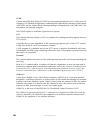187
www.gateway.com
NAT
Network Address Translation is an Internet standard that masks the internal IP addresses
being used in a LAN. A NAT server running on a gateway maintains a translation table
that maps all internal IP addresses in outbound requests to its own address and converts
all inbound requests to the correct internal host.
NAT serves three main purposes: it provides security by obscurity by hiding internal IP
addresses, enables the use of a wide range of internal IP addresses without fear of conflict
with the addresses used by other organizations, and it allows the use of a single Internet
connection.
Network Address
See IP Address.
NIC
A Network Interface Card is an adapter or expansion board inserted into a computer to
provide a physical connection to a network. Most NICs are designed for a particular type
of network, protocol, and media, for example, Ethernet or wireless.
NTP
The Network Time Protocol assures accurate synchronization of the system clocks in a
network of computers. NTP servers transmit Coordinated Universal Time (UTC, also known
as Greenwich Mean Time) to their client systems. An NTP client sends periodic time requests
to servers, using the returned time stamp to adjust its clock.
OSI
The Open Systems Interconnection (OSI) reference model is a framework for network design.
The OSI model consists of seven layers:
■ Layer 1, the Physical layer, identifies the physical medium used for communication
between nodes.
■ In the case of wireless networks, the physical medium is air, and radio frequency (RF)
waves are a components of the physical layer.
■ Layer 2, the Data-Link layer, defines how data for transmission will be structured and
formatted, along with low-level protocols for communication and addressing. For
example, protocols such as CSMA/CA and components like MAC addresses, and Frames
are all defined and dealt with as a part of the Data-Link layer.
■ Layer 3, the Network layer, defines the how to determine the best path for information
traversing the network. Packets and logical IP Addresses operate on the network layer.
■ Layer 4, the Transport layer, defines connection oriented protocols such as TCP and
UDP.


















